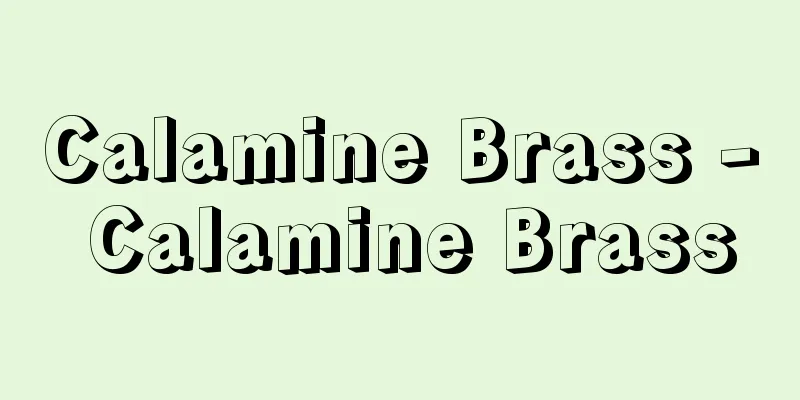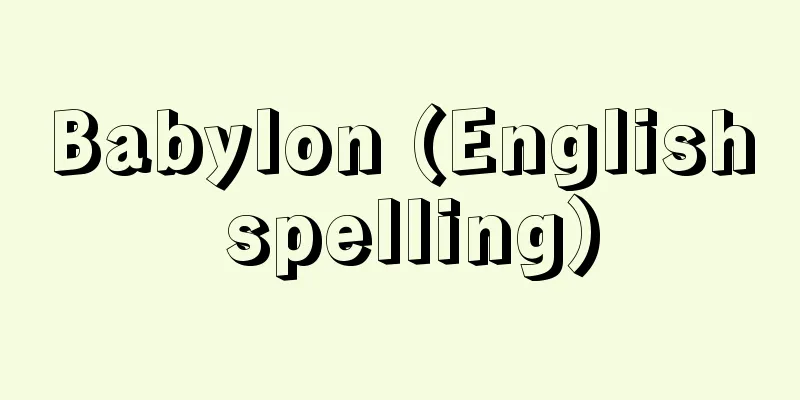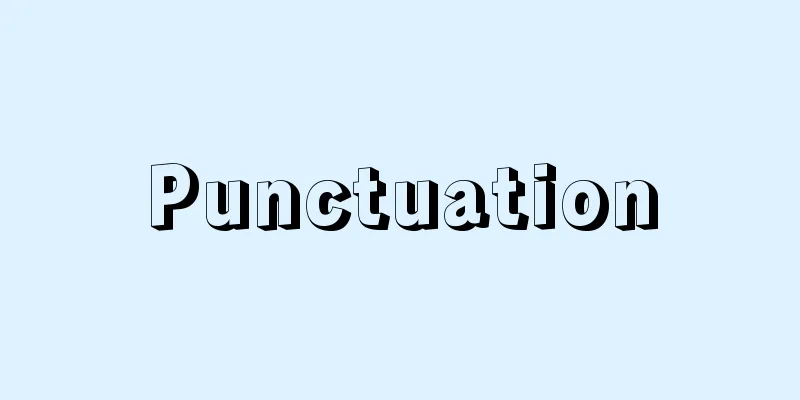Water quality standards

|
A standard for judging the suitability of water when it is used. Generally, it refers to the water quality standards for tap water based on the Water Supply Act, but it can also refer to the water quality standards for wastewater based on the Water Pollution Control Act, the water quality standards for sewage discharged from water pursuant to government ordinances under the Sewerage Act, or the water quality standards for swimming pools. It can also be used to mean the environmental standards for water based on the Basic Act for Pollution Control. [Sadayoshi Shigeta] Tap water quality standardsThe first condition for tap water is that it is free of pathogens, but it is technically difficult to detect pathogens from a large amount of water. However, if it can be proven that water is contaminated by human waste, it is expected that pathogens will be mixed in, so testing for the presence of coliform bacteria is important as a method to prove contamination by human waste. Also, when water is contaminated by human waste, chemically, urea and amino acids release ammonium salts, which are oxidized by bacteria to nitrate nitrogen and nitrite nitrogen. Therefore, if the amount of both substances is above a certain level, it is suspected to be contaminated by human waste and is not suitable for drinking. In addition, when there are a lot of chlorine ions, there is a suspicion of human waste contamination, but if there are no abnormalities in the number of bacteria or nitrogen compounds, it is considered to be due to the influence of geology or seawater, or past contamination, and the water is currently considered to be purified. In addition, since the amount of potassium permanganate consumed usually indicates the amount of organic matter in the water, a high organic matter content is almost always considered to be contaminated. The second condition for tap water is the regulation of substances that cause problems. Water quality standards indicate the allowable amounts of substances that cause problems if exceeded. These include limits that do not cause problems, such as for mercury, cyanide, hexavalent chromium, arsenic, lead, fluorine, and cadmium, as well as limit values set for iron, manganese, and phenols, which cause coloring, stains, odors, and other harmful effects. In addition, conditions such as appearance and taste are also taken into account for tap water. Furthermore, the concentration of population in cities, the development of industry, and the advancement of industrial technology have led to the contamination of water sources such as rivers and lakes, and the diversification and complexity of water pollution, which has led to an increase in problems such as unpleasant odors and tastes, and the generation of potentially carcinogenic trihalomethanes when organic substances in raw water combine with the chlorine used in water purification. For this reason, in December 1992, the Ministry of Health and Welfare (now the Ministry of Health, Labour and Welfare) carried out a major review of the water quality standards for tap water for the first time in about 30 years, expanding and strengthening the number of legally required items from the previous 26 to 46, as well as establishing 13 "comfortable water quality items" with the goal of supplying delicious water, and 26 "monitoring items" with the goal of improving safety in the future by dealing with new chemical substances, which came into effect in December 1993. In addition, 10 years had passed since the old standards were enacted, and new problems related to tap water quality had arisen, so the water quality standards were partially revised in 2003. The 13 newly added items are: Escherichia coli, boron, 1,4-dioxane, chloroacetic acid, dichloroacetic acid, bromine, trichloroacetic acid, formaldehyde, aluminum, dieosmin, 2-methylisoborneol, nonionic surfactants, and total organic carbon. The nine items that have been removed are: coliform bacteria, 1,2-dichloroethane, 1,1,2-trichloroethane, 1,3-dichloropropene, simazine, thiuram, thiobencarb, 1,1,1-trichloroethane, and organic matter (potassium permanganate consumption). [Sadayoshi Shigeta] Wastewater quality standardsBased on the Water Pollution Control Law, effluent standards required to maintain environmental standards for public water areas set standard values for substances that may cause damage to human health, such as cadmium and mercury, and indicators that may cause damage to the living environment, such as hydrogen ion concentration (pH) and chemical oxygen demand (COD). Regarding effluent standards for harmful substances that may cause health, based on the "Environmental Standards for the Protection of Human Health" expanded and strengthened in March 1993, new effluent standards were set for a total of 13 items, including organochlorine compounds such as dichloromethane and pesticides such as simazine, and standards for lead and arsenic were strengthened, and effluent regulations have been implemented since February 1994. Furthermore, these effluent standards are uniform throughout the country, but in water areas where it is difficult to achieve the environmental standards through unified effluent standards, prefectures can set stricter effluent standards by ordinance in addition. [Sadayoshi Shigeta] Wastewater quality standardsThe water quality standards for discharged sewage are set by government ordinance under the Sewerage Act, but if there are separate water quality standards set for each region under pollution-related laws, these must be followed. [Sadayoshi Shigeta] Water quality standards for swimming poolsThe Ministry of Health, Labour and Welfare has established the following water quality standards to prevent the occurrence of adenovirus infection, commonly known as pool disease, as well as skin diseases and diseases of the eyes, ears, nose and throat, etc., caused by microbial contamination in swimming pools. (1) The hydrogen ion concentration must be between pH 5.8 and 8.6. (2) Turbidity must not exceed 3 degrees. (3) Potassium permanganate consumption must not exceed 12 ppm. (4) The residual chlorine must be not less than 0.4 ppm for free chlorine or 1.0 ppm for total chlorine. (5) The most probable count for coliform bacteria per 100 milliliters must not exceed 5. [Sadayoshi Shigeta] [Reference items] | | | | | | |Source: Shogakukan Encyclopedia Nipponica About Encyclopedia Nipponica Information | Legend |
|
水を利用する際に、その水の適合性を判定する基準。一般には水道法に基づく水道水の水質基準のことをいうが、水質汚濁防止法に基づく排水の水質基準や、下水道法による政令で定められた放流下水の水質基準、あるいは遊泳用プールの水質基準をさすこともある。さらに公害対策基本法に基づく水の環境基準の意味に用いられることもある。 [重田定義] 水道水の水質基準水道水としての第一条件は病原体を含まないことであるが、多量の水から病原体を検出することは技術的には困難である。しかし、水が屎尿(しにょう)によって汚染されていることが証明できれば病原体の混入が予想されるため、屎尿による汚染の証明法として大腸菌群の有無の検査が重視される。また、水が屎尿で汚染されると、化学的には尿素やアミノ酸などがアンモニウム塩を遊離し、これが細菌によって硝酸性窒素、亜硝酸性窒素へと酸化される。したがって、両物質が一定量以上の場合には屎尿による汚染を疑って飲用不適となる。なお、塩素イオンが多いときにも、いちおう屎尿汚染の疑いが出るが、細菌数や窒素化合物などに異常がなければ、地質や海水の影響、あるいは過去の汚染と考えられ、現在は浄化されているとされる。このほか、過マンガン酸カリウム消費量は、通常、水中の有機物の含有量を表すことから、有機物が多いということは、ほとんどの場合汚染されていると考えられる。水道水の第二条件は、障害をおこす物質の規制である。水質基準では、ある量を超えると障害をおこす物質の許容量を示している。これには水銀、シアン、六価クロム、ヒ素、鉛、フッ素、カドミウムなどのように障害をおこさない限度を示したものと、鉄、マンガン、フェノール類などのように着色、汚れ、臭みなどの害に関連して定められた限界値とが含まれる。そのほか、水道水においては外観、味などの条件も加味されている。 さらに、人口の都市集中化、産業の進展、産業技術の進歩などは、河川、湖沼など水道水源の汚染、水質汚濁の多様化、複雑化をもたらし、異臭、異味などの被害が増加しており、また水道原水中の有機物質が、浄水処理において用いられる塩素と結合して、発癌(はつがん)性のおそれのあるトリハロメタンが生成されるといった問題が生じた。そのため厚生省(現厚生労働省)では1992年(平成4)12月に水道の水質基準を約30年ぶりに大幅に見直し、法律として遵守すべき項目は従来の26項目から46項目に拡充強化するとともに、おいしい水を供給することを目標とした「快適水質項目」13項目、将来に向けて新たな化学物質に対応し安全性向上を目標とした「監視項目」26項目を定め、1993年12月から施行した。また、旧基準から10年を経過し、新たな水道水質にかかわる問題が提起されたことをうけて、2003年に水質基準が一部改正された。新しく追加された項目は、大腸菌、ホウ素、1,4-ジオキシサン、クロロ酢酸、ジクロロ酢酸、臭素、トリクロロ酢酸、ホルムアルデヒド、アルミニウム、ジエオスミン、2-メチルイソボルネオール、非イオン界面活性剤、全有機炭素の13項目、除外した項目は、大腸菌群、1,2-ジクロロエタン、1,1,2-トリクロロエタン、1,3-ジクロロプロペン、シマジン、チウラム、チオベンカルブ、1,1,1-トリクロロエタン、有機物等(過マンガン酸カリウム消費量)の9項目である。 [重田定義] 排水の水質基準水質汚濁防止法に基づいて、公共用水域の環境基準を守るために必要とされる排水基準で、カドミウム、水銀など人の健康にかかわる被害を生じさせるおそれのある物質と、水素イオン濃度(pH)、化学的酸素要求量(COD)などのように生活環境にかかわる被害を生じさせるおそれのある指標についての基準値が設定されている。なお、健康にかかわる有害物質についての排水基準は、1993年3月に拡充強化された「人の健康の保護に関する環境基準」を踏まえ、ジクロロメタン等の有機塩素系化合物、シマジン等の農薬など合計13項目について新たに排水基準を設定し、また鉛およびヒ素について基準値の強化を行い、1994年2月から排水規制を実施している。また、この排水基準は全国一律であるが、統一的な排水基準によって環境基準を達成することが困難な水域においては、都道府県が条例により厳しい上乗せ排水基準を設定できることになっている。 [重田定義] 放流下水の水質基準下水道法による政令で定められた放流下水の水質基準であるが、公害関係の法律によって別に地域ごとに定められた水質基準がある場合はそれに従うこととなる。 [重田定義] 遊泳用プールの水質基準厚生労働省では、いわゆるプール病とよばれるアデノウイルス感染症をはじめ、皮膚疾患、眼・耳・鼻・咽喉(いんこう)などの疾患が遊泳用プールの微生物汚染によって発生することを予防するために、次のような水質基準を定めている。 (1)水素イオン濃度はpH5.8~8.6でなければならない。 (2)濁度は3度を超えてはならない。 (3)過マンガン酸カリウム消費量は12ppmを超えてはならない。 (4)残留塩素は遊離残留塩素において0.4ppmまたは総残留塩素において1.0ppm以上でなければならない。 (5)大腸菌群は100ミリリットル中の最確数が5を超えないこと。 [重田定義] [参照項目] | | | | | | |出典 小学館 日本大百科全書(ニッポニカ)日本大百科全書(ニッポニカ)について 情報 | 凡例 |
<<: Chū shī biǎo (English spelling)
>>: Water Pollution Prevention Law - Suishitsoodakuboushiho
Recommend
Istria Province - Istria
… The Venezia Giulia region, which is now the pro...
Archery - Jarai
During the Heian period, an archery ceremony was ...
Carbylamine
…It is also called carbylamine or isocyanide. It ...
Widukind (English spelling)
[raw]? [Death] 804/812 A Saxon leader who resisted...
Zug - Zug (English spelling)
The capital of the canton of Zug in central Switz...
Rachel
A character in the Old Testament. Jacob's wife...
Yoshinori Kinoshita
1898-1996 A Western-style painter from the Taisho...
Village invitation - Murake
〘Noun〙① (Abbreviation of "muraukeshinden (mur...
Cook Strait
A strait that separates the North and South Islan...
Uryu [town] - Uryu
A town in Uryu District, Hokkaido. It is located i...
Holy Cross - Shogei
A monk from the Muromachi period. He was the seve...
Fujinomiya [city] - Fujinomiya
This city occupies the area around the southwest f...
Alkaline foods
This refers to foods that contain more alkaline-f...
Klasse an sich (English spelling) Klasseansich
…If a class is aware that it has a mission as a c...
Ovarian tumor - Ovarian tumor
This refers to tumors that develop in the ovaries...









